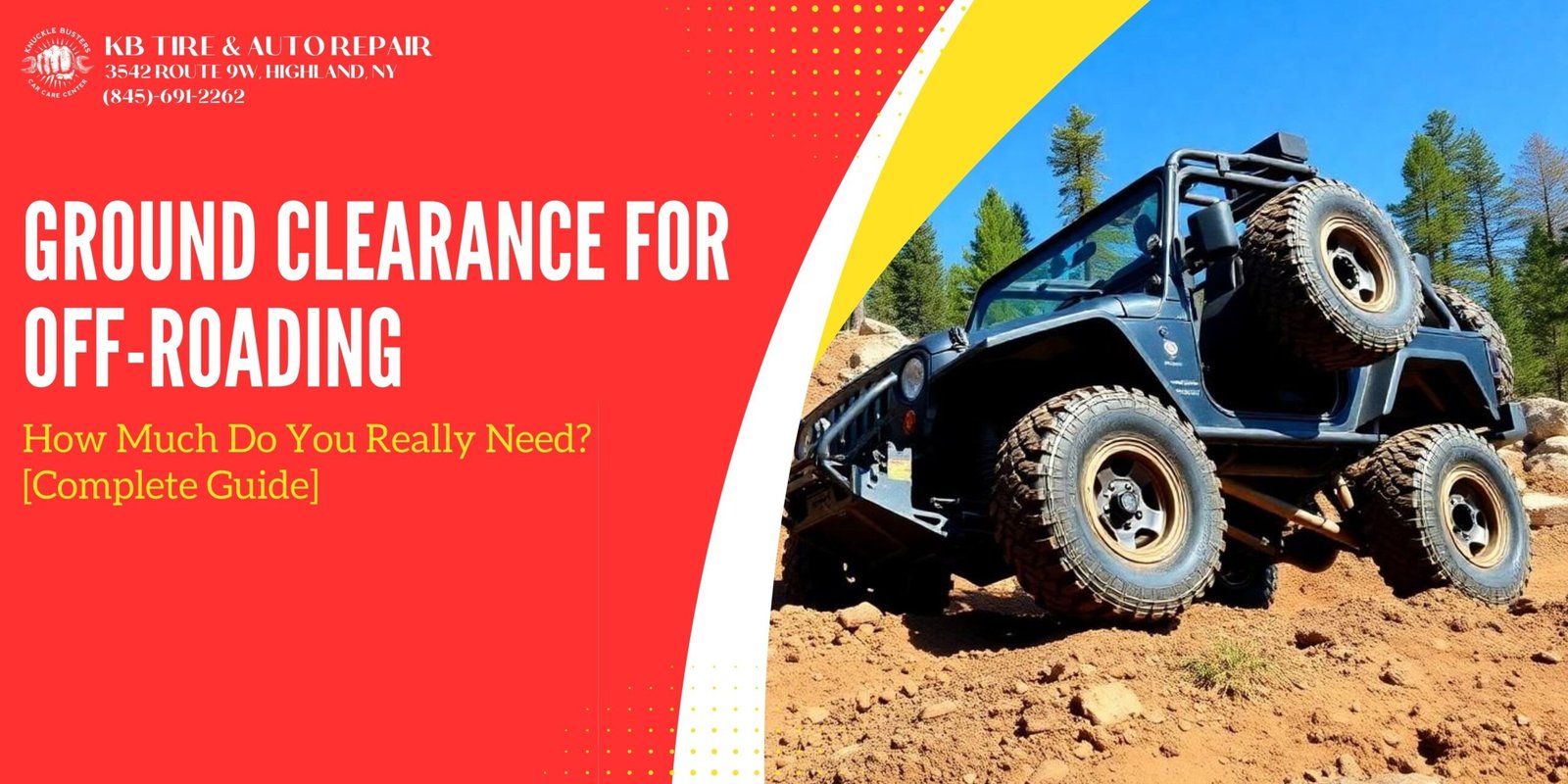Wondering if your vehicle has enough ground clearance for that upcoming off-road adventure? It’s a crucial question that could mean the difference between an exhilarating journey and getting stuck in the middle of nowhere.
The truth is, ground clearance requirements vary dramatically depending on the terrain you’ll tackle. While casual trail driving might only need 6-8 inches, serious rock crawling could demand 10-13 inches or more. Your specific off-roading goals, vehicle type, and the obstacles you’ll face all play vital roles in determining how much space you need between your undercarriage and Mother Nature.
In this guide, we’ll break down exactly how much ground clearance you’ll need for different off-road scenarios, how to measure it properly, and practical ways to increase it if your current setup falls short.
Understanding Ground Clearance in Off-Road Vehicles
Ground clearance is the minimum distance between your vehicle’s undercarriage and the ground. This critical measurement directly impacts your off-road capability and determines which obstacles you can safely navigate without damaging vital components like the differential, exhaust system, or oil pan.
What Is Ground Clearance?
Ground clearance refers to the space between the lowest point of your vehicle’s undercarriage and the ground surface. This measurement is typically taken when the vehicle is unloaded and on level ground. In off-road circles, it’s often called “running clearance” or “belly clearance” and represents how much room you have to clear obstacles without scraping or getting high-centered.
Most manufacturers list ground clearance as a single measurement, but experienced off-roaders know that several clearance points matter:
- Approach angle: The maximum angle you can drive up without the front bumper hitting
- Departure angle: The maximum angle you can drive down without the rear bumper hitting
- Breakover angle: The maximum height of an obstacle your vehicle can pass over without getting hung up
Why Ground Clearance Matters Off-Road
Ground clearance determines your vehicle’s ability to navigate challenging terrain without damaging critical components. With insufficient clearance, you’ll experience:
- Vehicle damage: Scraping your undercarriage on rocks, stumps, or dirt mounds
- Getting stuck: High-centering on obstacles when your wheels lose contact with the ground
- Limited accessibility: Being unable to tackle more challenging trails or terrain features
- Reduced performance: Having to constantly navigate around obstacles others can drive over
Proper ground clearance enhances your vehicle’s approach, departure, and breakover angles, allowing you to tackle steeper inclines, declines, and obstacles with confidence. For example, a Jeep Wrangler Rubicon with its 10.8 inches of clearance navigates rocky terrain much more capably than a standard SUV with 6-8 inches.
Measuring Your Vehicle’s Ground Clearance
To accurately measure your vehicle’s ground clearance:
- Park on level ground
- Find the lowest point underneath your vehicle (typically the differential, exhaust, or frame cross-member)
- Measure from this point to the ground using a ruler or measuring tape
Remember to measure when your vehicle is loaded with gear and passengers, as this can reduce actual clearance by 0.5-2 inches depending on your suspension setup and load weight.
For a comprehensive understanding, measure all critical points:
- Front differential
- Exhaust system
- Frame rails
- Oil pan
- Transmission case
- Rear differential
The lowest measurement among these points represents your actual usable ground clearance for off-road driving.
Minimum Ground Clearance Requirements for Different Terrains
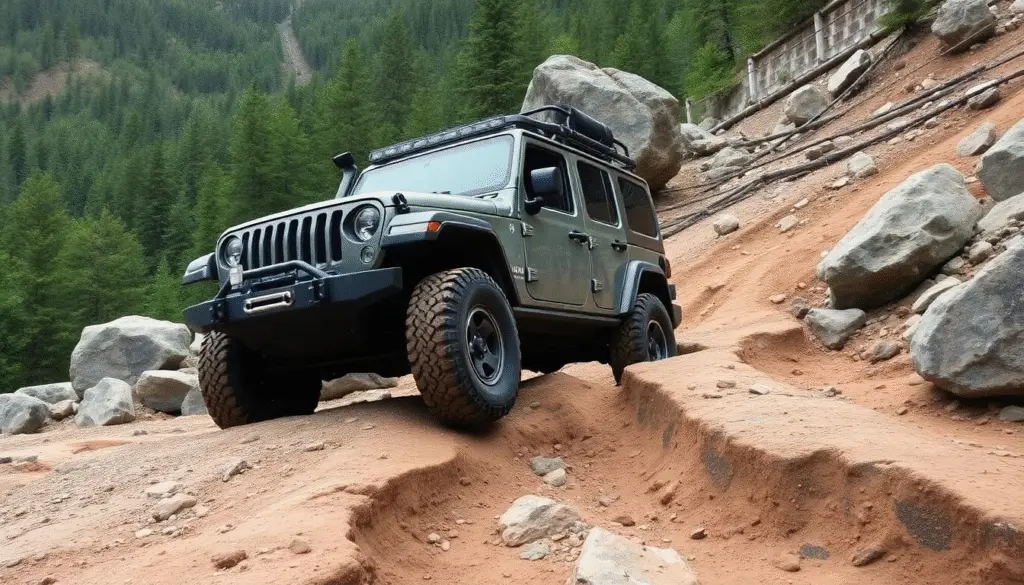
Different off-road environments demand specific ground clearance measurements to ensure safe passage and prevent vehicle damage. The required clearance varies significantly depending on the difficulty of the terrain you plan to tackle.
Mild Off-Road Trails and Dirt Roads
Mild off-road trails require a minimum ground clearance of 6-8 inches for comfortable navigation. These trails typically feature packed dirt roads, light gravel paths, and occasional shallow mud puddles or small roots. Stock SUVs and crossovers like the Subaru Outback (8.7 inches) or Toyota RAV4 (8.4 inches) provide sufficient clearance for these conditions. Even maintained forest service roads and light trails with minimal obstacles are accessible with this clearance range. For occasional weekend adventures on maintained trails, you don’t need extensive modifications to your vehicle’s ride height.
Moderate Rocky Terrain and Obstacles
Moderate off-road terrain demands 8-10 inches of ground clearance to navigate safely. These environments include trails with medium-sized rocks, deeper water crossings, more substantial ruts, and moderate inclines. Vehicles like the Jeep Wrangler (9.7 inches) or Toyota 4Runner (9.6 inches) excel in these conditions without modifications. When tackling this terrain, pay attention to your approach and departure angles in addition to ground clearance. Moderate obstacles such as fallen logs, shallow creek beds, and uneven surfaces become accessible with this clearance range, but you’ll still need careful tire placement and occasional spotting.
Extreme Off-Road Conditions and Rock Crawling
Extreme off-road environments necessitate at least 10-13 inches of ground clearance, with serious rock crawling often requiring even more. These challenging terrains feature large boulders, deep ravines, steep climbs, and substantial obstacles that test even purpose-built vehicles. The Jeep Wrangler Rubicon (10.8 inches) and Ford Bronco Badlands (11.6 inches) offer impressive stock clearance, but many enthusiasts modify these further. To handle extreme conditions, your vehicle needs not only substantial ground clearance but also enhanced articulation, locking differentials, and proper skid plates. Large rock formations, deep mud pits, and technical mountain trails demand this level of clearance to prevent undercarriage damage and avoid getting stranded.
How Vehicle Type Affects Ground Clearance Needs
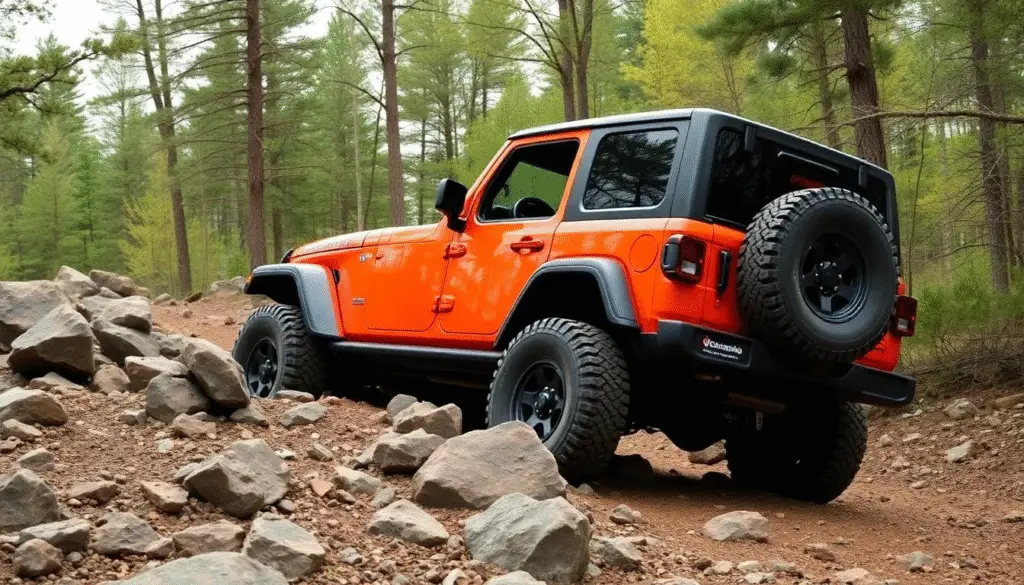
Your vehicle type significantly influences how much ground clearance you’ll need for off-roading adventures. Different vehicle categories come with varying stock clearance heights and capability limits that determine which terrains you can safely navigate.
SUVs and Crossovers
Most crossovers offer 6.5-8.5 inches of ground clearance, making them suitable for light off-road use on maintained trails and gravel roads. Subcompact crossovers like the Subaru Crosstrek (8.7 inches) and Honda HR-V (7.5 inches) provide adequate clearance for forest service roads and mild obstacles. Full-size SUVs typically offer better clearance, with models like the Chevrolet Tahoe (8 inches) and Ford Expedition (9.8 inches) handling moderate off-road conditions. Crossovers with independent suspension systems often sacrifice articulation for on-road comfort, limiting their performance on uneven terrain despite reasonable ground clearance.
Pickup Trucks
Pickup trucks generally provide 8-10 inches of ground clearance from the factory, with their body-on-frame construction offering superior durability for off-road conditions. Mid-size trucks like the Toyota Tacoma (9.4 inches) and Chevrolet Colorado ZR2 (8.9 inches) balance everyday usability with off-road capability. Full-size trucks such as the Ford F-150 Raptor (11.5 inches) and RAM 1500 TRX (11.8 inches) deliver exceptional clearance for challenging terrain. Trucks with longer wheelbases have reduced breakover angles compared to shorter vehicles with similar ground clearance, affecting their performance on steep crests and dips despite having good approach and departure angles.
Dedicated Off-Road Vehicles
Purpose-built off-road vehicles offer 9-13+ inches of ground clearance and are designed specifically for tackling difficult terrain. The Jeep Wrangler Rubicon (10.8 inches) and Ford Bronco Sasquatch (11.6 inches) feature solid axles for superior articulation over obstacles. These vehicles include specialized components like skid plates, enhanced suspension travel, and reinforced chassis elements to protect vital components. Many dedicated off-roaders come with factory lift kits or are easily modified to increase ground clearance beyond stock specifications. The Toyota 4Runner TRD Pro (9.6 inches) and Land Rover Defender (11.5 inches) combine impressive ground clearance with advanced traction control systems to maximize off-road capability in various conditions.
Other Important Factors Beyond Ground Clearance

While ground clearance is essential for off-road driving, several other factors significantly impact your vehicle’s off-road performance. These elements work together with ground clearance to determine how effectively your vehicle navigates challenging terrain.
Approach and Departure Angles
Approach and departure angles complement your vehicle’s ground clearance by determining its ability to navigate steep obstacles. The approach angle measures the maximum incline your vehicle can climb without the front bumper scraping, while the departure angle indicates how steep a decline you can descend without damaging the rear. Vehicles with higher approach angles (30+ degrees) like the Jeep Wrangler handle steep inclines better than those with lower angles (under 20 degrees) typical in passenger cars. For serious off-roading, look for approach angles of at least 28 degrees and departure angles of 25+ degrees to prevent costly damage when tackling hills and obstacles.
Breakover Angle
The breakover angle determines your vehicle’s ability to crest hills without high-centering. This measurement represents the maximum angle between your tires where the vehicle can pass over a peak without the undercarriage making contact. Vehicles with longer wheelbases typically have smaller breakover angles, making them more prone to getting stuck on ridge crests or large rocks. Short-wheelbase 4x4s like the Jeep Wrangler 2-door (with a breakover angle of approximately 27.8 degrees) offer advantages on technical terrain compared to longer vehicles like crew cab trucks that might have breakover angles under 20 degrees.
Tire Size and Suspension
Tire size and suspension design dramatically affect your off-road capability beyond basic ground clearance measurements. Larger tires instantly increase functional ground clearance—moving from stock 31-inch tires to 35-inch tires can add 2 inches of clearance at the differential. Quality suspension systems with adequate travel (8+ inches) allow your wheels to maintain contact with uneven terrain, improving traction where it matters most. Suspension articulation, measured by the Ramp Travel Index (RTI), indicates how well your vehicle keeps its wheels on the ground when one side is elevated. Advanced suspension systems like those with disconnecting sway bars provide better articulation, allowing your tires to conform to the terrain and maintain traction in challenging conditions where ground clearance alone isn’t sufficient.
Modifying Your Vehicle for Better Ground Clearance
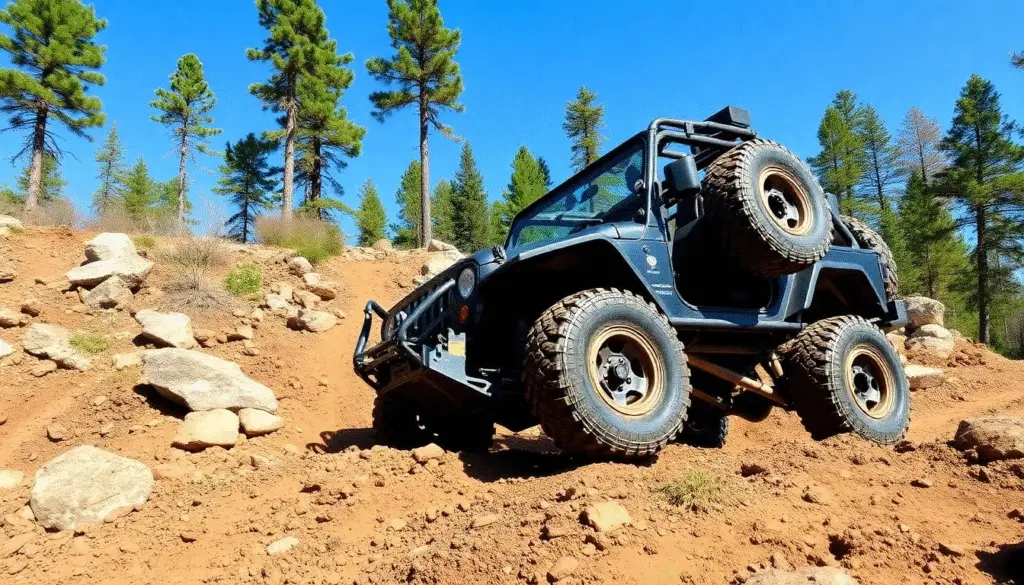
Increasing your vehicle’s ground clearance is one of the most effective ways to enhance its off-road capability. Modifications can transform even stock vehicles into capable off-road machines by creating more space between vulnerable undercarriage components and trail obstacles.
Lift Kits and Suspension Upgrades
Lift kits raise your vehicle’s body or frame to create additional ground clearance for off-road driving. Body lifts use spacers between the body and frame to gain 1-3 inches of clearance without affecting suspension geometry. Suspension lifts replace factory components with taller springs, shocks, and control arms to achieve 2-6+ inches of additional height.
Suspension upgrade options include:
- Coil spacers: Affordable option adding 1-2 inches of lift
- Complete lift kits: Comprehensive packages providing 2-6+ inches with properly engineered components
- Long-travel suspension: Premium systems offering increased wheel travel and articulation for serious off-roading
Quality suspension upgrades don’t just increase ground clearance—they improve articulation, allowing your wheels to maintain contact with uneven terrain. This enhanced flexibility helps prevent high-centering when crossing obstacles with substantial ground clearance requirements.
Larger Tires and Their Impact
Installing larger tires is often the most straightforward way to gain functional ground clearance for off-road driving. Each inch of increased tire diameter typically adds about half an inch of clearance at the differential—the lowest point on most 4×4 vehicles.
Tire size benefits include:
- Immediate clearance gains: A jump from 33″ to 35″ tires adds approximately 1″ of real-world clearance
- Improved traction: Larger tires typically feature more aggressive tread patterns
- Better obstacle rollover: Larger diameter helps wheels climb over rocks and roots
Tire modifications require consideration of complementary changes:
| Modification Consideration | Details | Impact on Ground Clearance |
|---|---|---|
| Wheel backspacing | Less backspacing widens stance | Improves stability but doesn’t directly increase clearance |
| Fender modifications | Trimming or aftermarket fenders | Allows for larger tires without rubbing |
| Regearing | Lower (numerically higher) gear ratios | Compensates for larger tire diameter to maintain performance |
When determining how much ground clearance you need for off-road adventures, remember that tire upgrades complement suspension lifts—combining both approaches often yields the best results for serious terrain. Most dedicated off-road enthusiasts find that a 2-3 inch suspension lift paired with tires that are 2-4 inches larger than stock provides the optimal balance of improved clearance without compromising on-road handling.
Common Ground Clearance Mistakes to Avoid
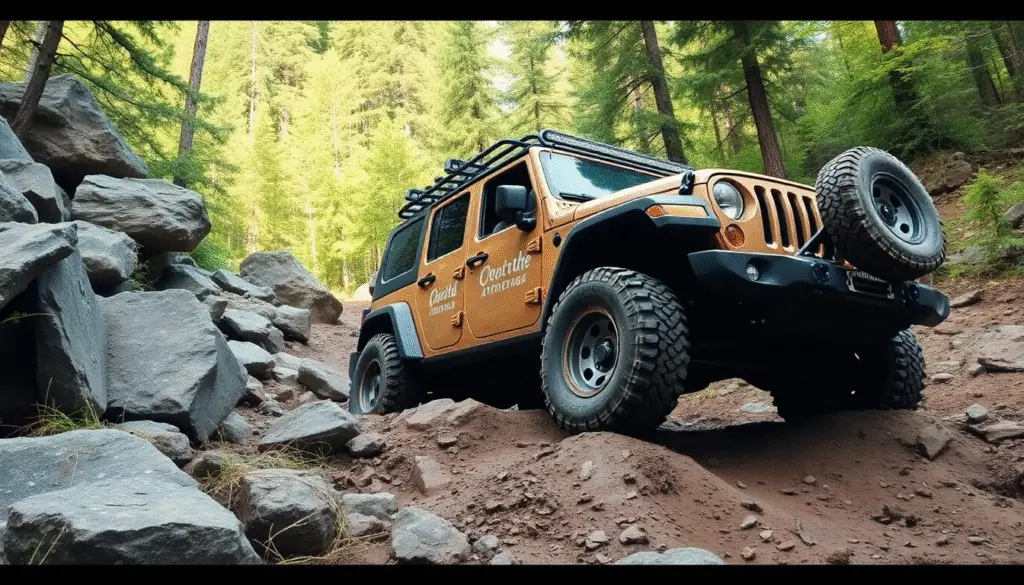
Underestimating Terrain Requirements
Underestimating terrain difficulty leads to vehicle damage and frustrating off-road experiences. Many off-roaders misjudge how much ground clearance they need based on photos or videos alone. A trail labeled as “moderate” might contain sections requiring significantly more clearance than the trail’s average. Before heading out, research the specific terrain features you’ll encounter, including large rocks, deep ruts, and water crossings. Speak with experienced drivers who’ve recently navigated the same trails for accurate clearance requirements.
Focusing Only on Static Clearance
Static clearance measurements don’t tell the complete story of your vehicle’s off-road capability. Your vehicle’s suspension compresses when driving, especially when hitting obstacles or traversing uneven terrain. This compression temporarily reduces your effective ground clearance by 1-3 inches. Factor in dynamic clearance reduction when planning your off-road adventures. A vehicle with 10 inches of static clearance might effectively have only 7-8 inches when the suspension compresses under load or during articulation.
Overlooking Critical Low Points
Many off-roaders focus solely on differential clearance while ignoring other vulnerable components. Critical low points on your vehicle include:
- Exhaust systems and catalytic converters
- Fuel tanks and fuel lines
- Transfer case skid plates
- Steering components
- Low-hanging steps or running boards
A single overlooked low point can result in expensive damage, even when your differential clears obstacles easily. Conduct a thorough under-vehicle inspection to identify all potential hang-up points before hitting challenging trails.
Improper Modification Approaches
Lifting your vehicle incorrectly creates more problems than it solves. Common modification mistakes include:
- Installing only body lifts without addressing suspension
- Adding excessive lift without upgrading control arms
- Choosing oversized tires without considering fender clearance
- Neglecting to recalibrate speedometers after significant changes
- Focusing on height while ignoring approach and departure angles
Rushed or poorly planned modifications often lead to reduced reliability, compromised handling, and expensive repairs. Consult with experienced off-road shops before making significant changes to your vehicle’s clearance.
Ignoring Weight Distribution
Vehicle loading significantly affects your usable ground clearance for off-road driving. Heavy cargo, passengers, and gear can compress your suspension by 1-2 inches, reducing your clearance when you need it most. Roof-loaded items raise your center of gravity while simultaneously decreasing ground clearance through suspension compression. Distribute weight evenly and consider leaving non-essential items behind for challenging trails where maximum clearance is needed.
Conclusion
Choosing the right ground clearance for your off-road adventures isn’t one-size-fits-all. Your needs will depend on your typical terrain mild trails require 6-8 inches while extreme rock crawling demands 10+ inches.
Remember that effective clearance involves more than just height it’s about approach angles suspension quality and tire selection too. Whether you’re driving a stock SUV or planning modifications like lift kits and larger tires make sure your adjustments are balanced and appropriate for your vehicle.
By understanding your specific ground clearance requirements and making thoughtful modifications you’ll enjoy more successful adventures with less vehicle damage. The right setup lets you focus on the thrill of off-roading rather than worrying about what’s underneath your vehicle.
Frequently Asked Questions
What is ground clearance and why is it important for off-roading?
Ground clearance is the minimum distance between your vehicle’s undercarriage and the ground. It’s crucial for off-roading because it determines your ability to navigate over obstacles without damaging vital components like the differential or exhaust system. Sufficient clearance prevents getting stuck, reduces vehicle damage risk, improves accessibility to remote areas, and enhances overall off-road performance.
How much ground clearance do I need for different terrains?
For mild trails and dirt roads: 6-8 inches (suitable for stock SUVs like Subaru Outback)
For moderate rocky terrain: 8-10 inches (Jeep Wrangler, Toyota 4Runner)
For extreme conditions and rock crawling: 10-13+ inches (typically modified vehicles)
Your terrain choice dictates the minimum clearance needed for a safe, damage-free experience.
How do I measure my vehicle’s ground clearance accurately?
Measure from the ground to the lowest point of your vehicle’s undercarriage (typically the differential, exhaust, or chassis crossmember). For accuracy, measure while the vehicle is loaded with gear and passengers to account for suspension compression. Check multiple points underneath to identify the true lowest point that will determine your functional clearance.
What are approach, departure, and breakover angles?
These angles determine your vehicle’s ability to handle obstacles without scraping:
- Approach angle: Maximum incline you can climb without front-end contact
- Departure angle: Maximum descent without rear-end contact
- Breakover angle: Ability to crest hills without high-centering
Higher angles mean better off-road capability on steep terrain.
Do different vehicle types have different ground clearance needs?
Yes. Crossovers typically offer 6.5-8.5 inches (good for light off-roading), full-size SUVs provide slightly more clearance for moderate conditions, pickup trucks generally have 8-10 inches, and dedicated off-road vehicles feature 9-13+ inches with specialized components. Your vehicle type largely determines your baseline clearance before any modifications.
What other factors besides ground clearance affect off-road capability?
Key factors include approach/departure angles, breakover angle, tire size, and suspension design. Larger tires improve functional clearance and provide better traction. Quality suspension systems with good articulation maintain wheel contact on uneven terrain. These elements work together with ground clearance to determine overall off-road performance.
How can I increase my vehicle’s ground clearance?
The most effective methods include:
- Lift kits (body or suspension lifts)
- Larger tires (each inch of tire diameter adds about half an inch of clearance)
- Suspension upgrades (coil spacers or long-travel systems)
For optimal results, combine a 2-3 inch suspension lift with tires 2-4 inches larger than stock.
What common ground clearance mistakes should I avoid?
Avoid underestimating terrain requirements, focusing only on static clearance (ignoring suspension compression), overlooking critical low points on your vehicle, rushing modifications without proper research, and ignoring weight distribution. These mistakes can lead to vehicle damage, getting stuck, or compromised reliability on the trail.
